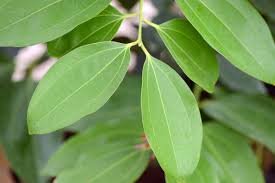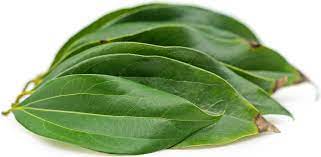Cinnamon leaves come from the Cinnamomum verum tree, also known as true cinnamon or Ceylon cinnamon. The leaves are an important part of the cinnamon plant and are often used in traditional medicine, culinary applications, and for various aromatic purposes.
Cinnamons leaves are typically shiny, dark green, and have an elliptical or lanceolate shape. They are arranged alternately on the branches of the cinnamon tree. The leaves have a smooth texture on the upper surface and a slightly paler, more matte appearance on the underside. The size of cinnamon leaves varies, but they generally measure around 10 to 18 centimeters (4 to 7 inches) in length and 2 to 7 centimeters (0.8 to 2.8 inches) in width.
Cinnamon leaves have a distinctive, sweet, and spicy fragrance, reminiscent of the warm and inviting scent associated with cinnamon spice. The aroma is attributed to the presence of essential oils within the leaves, including cinnamaldehyde, eugenol, and linalool. While not typically consumed directly like cinnamon bark, cinnamon leaves can impart a mild, somewhat peppery, and slightly sweet taste when used in culinary applications or infused in teas.
Cinnamon leaves are used in various cuisines to add a subtle cinnamon flavor to dishes. They can be used to flavor curries, stews, soups, and teas. The leaves are often used in their fresh or dried form. In traditional medicine, cinnamon leaves are believed to have antiseptic, analgesic, and anti-inflammatory properties. They are used in herbal remedies to address various ailments, including digestive issues, respiratory problems, and muscle pain.
Cinnamon has a long history of use in various cultures around the world. It was highly prized in ancient civilizations for its aromatic properties and was often used in religious ceremonies, embalming processes, and as a valuable trade commodity. The Cinnamomum verum tree, which yields cinnamon leaves, is typically grown in tropical and subtropical regions. The leaves are harvested by hand, usually as needed, and can be used fresh or dried.
Cinnamon leaves play a significant role not only in enhancing flavors in cooking but also in traditional medicine and cultural practices, making them a versatile and valuable component of the cinnamon plant.
The Economic Importance and Uses of Cinnamon Leaves

Cinnamons leaves, scientifically known as Cinnamomum verum, are an important plant with economic significance due to various uses in culinary, medicinal, and industrial applications.
Here are the economic importance and uses of cinnamon leaves:
1. Flavoring Agent: Cinnamons leaves are used to add a distinct and aromatic flavor to a wide range of culinary dishes, including desserts, beverages, curries, stews, and soups.
2. Bakery and Confectionery: Cinnamon leaves and their extracts are essential ingredients in baking, making cinnamon rolls, cookies, pies, and other confectionery items.
3. Traditional Medicine: Cinnamon leaves are used in traditional medicine for their potential health benefits, including anti-inflammatory, anti-microbial, anti-fungal, and antioxidant properties.
4. Digestive Aid: Cinnamon leaves can aid digestion and help alleviate gastrointestinal discomfort, such as bloating and indigestion.
5. Essential Oil Extraction: Cinnamon leaves are a source of cinnamon leaf oil, which is used in perfumes, aromatherapy, and the production of essential oils. The oil is obtained through steam distillation of the leaves.
6. Culinary Spice: Cinnamons leaves are a valuable spice used globally, contributing to the spice industry’s growth and economic value.
7. Natural Cosmetics: Cinnamon leaf extracts are used in the production of natural and herbal cosmetics, including soaps, lotions, and other personal care products.
8. Aromatherapy: Cinnamon leaf oil is used in aromatherapy for its soothing and relaxing properties.
9. Insect Repellent: Cinnamon leaf oil is used as a natural insect repellent, providing an alternative to chemical-based repellents. It is effective against mosquitoes, flies, and other pests.
10. Flavorings and Fragrances: The unique aroma of cinnamon leaves is utilized in the production of various flavorings and fragrances for food, beverages, perfumes, and household products.
11. Tea and Infusions: Cinnamons leaves are used to flavor teas and infusions, providing a spicy and aromatic element to the beverages.
Read Also: Cocoyam Roots: Economic Importance, Uses, and By-Products
12. Dietary Supplements: Cinnamon leaf extracts are used in dietary supplements, often marketed for their potential health benefits, including blood sugar management and immune system support.
The Products and By-products That Can Be Derived From Cinnamon Leaves

Cinnamon leaves, derived from the Cinnamomum verum or Cinnamomum cassia tree, can be used to produce various products and by-products.
Here’s a list and explanation of some of them:
1. Cinnamon Essential Oil: Extraction of essential oil from cinnamon leaves is a primary product. It’s widely used in aromatherapy, perfumery, food flavoring, and pharmaceuticals due to its aromatic and therapeutic properties.
2. Cinnamon Leaf Extract: This extract is obtained by macerating cinnamon leaves in a suitable solvent. It’s used in cosmetics, pharmaceuticals, and sometimes in food products for its flavor and potential health benefits.
3. Cinnamon Powder: Dried cinnamon leaves can be ground into a powder. Cinnamon powder is a popular spice used in cooking, baking, and as a flavor enhancer in various dishes and beverages.
4. Cinnamon Tea: Cinnamon leaves can be dried and used to make cinnamon tea, which is known for its soothing and potentially health-beneficial properties.
5. Cinnamon Capsules or Supplements: Ground cinnamons leaves can be encapsulated to create dietary supplements for potential health benefits like blood sugar control and anti-inflammatory effects.
6. Cinnamon-infused Oils: Cinnamons leaves can be infused in carrier oils to create aromatic massage oils, which may have relaxing and therapeutic effects.
7. Cinnamon-Flavored Foods and Beverages: Cinnamon leaves or extracts are used to flavor a wide range of foods and beverages, including pastries, desserts, coffee, tea, and more.
8. Cinnamon Potpourri: Dried cinnamon leaves or cinnamon powder can be used in potpourri mixtures for their aromatic properties, often placed in decorative bowls or sachets.
9. Cinnamon Scented Candles and Incense: Cinnamon leaf oil or powdered cinnamon can be used to create scented candles or incense, providing a pleasant aroma in homes or religious spaces.
10. Cinnamon-based Air Fresheners: Extracts or oils from cinnamon leaves can be used to create air fresheners, sprays, or diffusers for homes and commercial spaces.
11. Animal Feed Additive: Cinnamon leaves can be utilized as an additive in animal feed due to potential health benefits for livestock, including its possible role in improving digestion and reducing stress.
12. Compost or Organic Fertilizer: Cinnamon leaves, when decomposed, can be used as organic matter for composting or as a natural fertilizer for plants.
13. Cinnamon Leaf Hydrosol: Steam distillation of cinnamon leaves can yield a hydrosol, which has a milder aroma compared to the essential oil. It can be used in skincare or as a facial toner..
In conclusion, cinnamons leaves have a diverse range of economic uses, from enhancing the flavor of foods and beverages to their role in traditional medicine, cosmetics, aromatherapy, insect repellents, and essential oil production. These applications contribute to their economic importance and value across various industries.
Read Also: What Are the Benefits of Crayfish?

